PxPvdInstrumentationFlag Struct Reference
[Pvd]
types of instrumentation that PVD can do.
More...
#include <PxPvd.h>
List of all members.
Detailed Description
types of instrumentation that PVD can do.
Member Enumeration Documentation
- Enumerator:
-
| eDEBUG |
Send debugging information to PVD.
This information is the actual object data of the rigid statics, shapes, articulations, etc. Sending this information has a noticeable impact on performance and thus this flag should not be set if you want an accurate performance profile. |
| ePROFILE |
Send profile information to PVD.
This information populates PVD's profile view. It has (at this time) negligible cost compared to Debug information and makes PVD *much* more useful so it is quite highly recommended.
This flag works together with a PxCreatePhysics parameter. Using it allows the SDK to send profile events to PVD. |
| eMEMORY |
Send memory information to PVD.
The PVD sdk side hooks into the Foundation memory controller and listens to allocation/deallocation events. This has a noticable hit on the first frame, however, this data is somewhat compressed and the PhysX SDK doesn't allocate much once it hits a steady state. This information also has a fairly negligible impact and thus is also highly recommended.
This flag works together with a PxCreatePhysics parameter, trackOutstandingAllocations. Using both of them together allows users to have an accurate view of the overall memory usage of the simulation at the cost of a hashtable lookup per allocation/deallocation. Again, PhysX makes a best effort attempt not to allocate or deallocate during simulation so this hashtable lookup tends to have no effect past the first frame.
Sending memory information without tracking outstanding allocations means that PVD will accurate information about the state of the memory system before the actual connection happened. |
| eALL |
|
The documentation for this struct was generated from the following file:
Copyright © 2008-2017 NVIDIA Corporation, 2701 San Tomas Expressway, Santa Clara, CA 95050 U.S.A. All rights reserved.
www.nvidia.com
